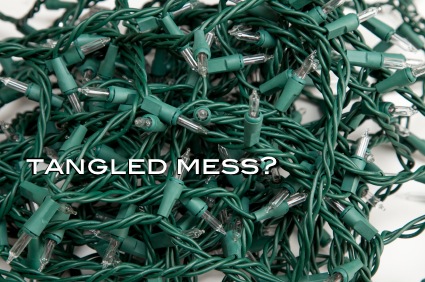 Sitting on the floor in a pool of winter sunshine, I contemplated the similarities between the pile of tangled holiday lights before me, and the conflict that arises in our most important relationships. Read on to learn 3 ways that a pile of tangled holiday lights taught me important lessons about how to handle conflict with people I love…
Sitting on the floor in a pool of winter sunshine, I contemplated the similarities between the pile of tangled holiday lights before me, and the conflict that arises in our most important relationships. Read on to learn 3 ways that a pile of tangled holiday lights taught me important lessons about how to handle conflict with people I love…
Yesterday morning, I had the unenviable task of taking down the holiday décor and storing it away for the year. Normally, I would simply shove everything into a storage bin and “deal with it” next year. But this year I was determined to do it differently - sorting and organizing all of the old stuff in the storage bins, so that next season will start a little bit better. This included a huge tangle of holiday lights that I have been carting around with me for decades.
So there I sat in the middle of the floor in a pool of winter sunshine, with piles of holiday lights surrounding me. For a moment, I entertained the idea of simply tossing it all away, but the environmentalist in me wouldn’t allow it. I had to untangle the mess.
So as I sat, I thought about three ways that this mess of holiday lights is very much like the deeply entangled conflicts that we experience in our most important and enduring relationships.
First, it’s hard to tell where the whole mess starts.
Second, enough broken lights make the whole string un-savable.
Third, both are durable and fragile at the same time, so proceed with care.
Let me explain.
3 Ways that Conflict in a Relationship is like a Pile of Tangled Holiday Lights
1) It’s hard to tell where the whole mess starts.
As I stared at the pile of lights, I realized that there were many beginnings and many endings- all tangled together.
When we find ourselves in conflict, the “beginning” is often not the same moment for each of the people involved. In fact, there are usually as many different interpretations of the “beginning” as there are people involved in the conflict.
A recent conflict I had with my husband started with the fact that he didn’t fold the laundry- for me. For him, the conflict started with my tone of voice when I asked about the laundry (touché). In the study of communication, we call this, “punctuation.” We look for the ways that the different parties in the conflict punctuate events so that we can gain a deeper understanding of the dynamic and gain insight into the moments when our emotions have gotten triggered.
Sometimes, the difference in how two people interpret the beginning of a conflict can result in a deadlock. Instead of acknowledging that “the beginning” is a matter of interpretation subject to our own unique perspective, disputants will grip tightly to some version of the “you started it” refrain, hoping to force the other person to offer the first apology. This rarely works as it creates an attack-defend cycle that requires great humility to break.
Instead, acknowledge that the starting point may be different for each person. Own your behaviors. No matter who or what started the conflict, it cannot go on without both parties playing a part. Listen with empathy to the other person’s interpretation, and apologize for the part that you played. This is the only way to begin to untangle the mess.
2) Enough broken lights make the whole string un-savable.
Relationships are made moment by moment over time. For relationships to be healthy, they need many positive interactions (bright lights). If there are enough positive interactions, then a relationship can survive some proportion of negative interactions. But at some point, we start doing the math. Are there enough bright lights to make this string worth saving? Or have the broken lights taken over, making the whole string unworthy of our time and attention?
Don’t get me wrong. I don’t see relationships as simple cost/benefit equations. There is so much more holding us together than simple calculations. But when there is more conflict than happiness, or more broken moments than shiny ones, then we begin to make different choices. We may simply retreat into ourselves, avoiding interaction. Or we may choose to censor what we say to our partner, thereby reducing our capacity for intimacy and connection.
Instead, do your best to fix the broken lights and bring your best self to the relationship. Make a concerted effort to have “bright” moments regularly and often. This will make today more enjoyable, and will also make your relationship more resilient when times get tough.
3) Both holiday lights and people in conflict are durable and fragile at the same time.
This is no surprise. Every person has his or her vulnerabilities and “delicate” aspects, and every person is durable and resilient in some ways. Look for the strengths and handle the delicate parts with care- especially in conflict.
There is a way that we can become ruthless in conflict – “taking off the gloves,” and “going for the throat.” Resist this temptation. Know that you will feel much better about yourself at the end of the day if you can refrain from breaking fragile lights while you are in conflict. Though others are indeed durable, there is no need to be thoughtless or cruel. You never know when you may break the one most important light- the one that powers the whole string.
So, while I was duly entertained by my musings about the similarities between strings of holiday lights and people in conflict, I still had the unanswered question…what will I do with the mess? I entertained 3 options before deciding on the right course of action.
Resolving Conflict: 4 options to decide on the right course of action.
Toss the whole thing away and start fresh?
The lights, maybe. An important relationship, no. Not a good plan. Too much invested. Keep untangling.
Force it apart- probably creating more damage than it’s worth.
Not this time. Forcing doesn’t usually work. It creates the wrong energy in a relationship, and, like holiday lights, usually results in more damage than relief.
Shove it back in the box and wait another year?
While it is true that time heals, and sometimes it is a great choice to just walk away and come back later, I figured that this time was the right time to face the mess head on.
Quietly, patiently, and gently tease apart the tangle- unraveling the “stuck-ness” when possible- replacing the bad lights with good, and re-packaging the whole string with care.
This was my choice this year. So I sat in that pool of sunshine and untangled the mess with care. For 2014, I will make an effort to fill my relationships with bright moments, acknowledge that there are many beginnings and endings, and continue to be gentle when untangling the stuck places.
 Written by Claire Laughlin, Consultant & Trainer, Leadership 4 Design- As an independent consultant and trainer with 20 years of diverse experience, Claire Laughlin brings a passion for improving relationships, experience in management, and a relentless dedication to transformation to all of her work. She is fully committed to working with individuals, teams, and organizations as they learn and cultivate the habits and practices that make their organizational dynamics healthy and highly productive. Claire's experience spans Leadership to Communication Essentials to Project Management & Customer Service and has designed and taught over one hundred courses at over 60 organizations and seven different colleges and universities. In addition to her consultancy work, Claire directs Cabrillo College's Corporate Training Program.
Written by Claire Laughlin, Consultant & Trainer, Leadership 4 Design- As an independent consultant and trainer with 20 years of diverse experience, Claire Laughlin brings a passion for improving relationships, experience in management, and a relentless dedication to transformation to all of her work. She is fully committed to working with individuals, teams, and organizations as they learn and cultivate the habits and practices that make their organizational dynamics healthy and highly productive. Claire's experience spans Leadership to Communication Essentials to Project Management & Customer Service and has designed and taught over one hundred courses at over 60 organizations and seven different colleges and universities. In addition to her consultancy work, Claire directs Cabrillo College's Corporate Training Program.
Do you have a question for Claire? Please visit our Workplace Communication Skills Community, she will be happy to help: Ask an Expert